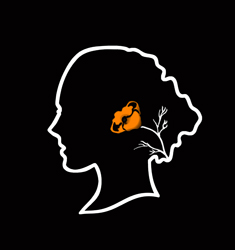Ernestine's portrait was purposefully painted in egg tempera. This is a medium that I thoroughly enjoy. It is a meditative experience from beginning to end. It requires mixing the dry ground paint pigment ( which is usually color from the earth or rock) mixed with egg yolk, distilled water and a dash of vodka (the technique I learned was from the Russian icon artists).
Analysis of the Portrait of Dr. John Johnson
By Amy Hauldren
Amy Hauldren,
UCSB Intern, Communications Major from Chicago
Artist Holli Harmon has created a portrait of Dr. Johnson that reflects both his own anthropological expertise, and the importance of the Chumash culture to the history of the Santa Barbara area. After thinking about how to represent the field of anthropology and academia in general, Holli decided that the sky was the best way to represent these ideas, because it implies a broad opening of infinite knowledge. The field of anthropology is so vast, dealing with mysteries of the past that can be uncovered to help us understand our own role as humans existing in the present and future.
She decided to paint the portrait in watercolor, a very fluid medium that allowed her to embed Chumash symbols into the work. The fluidity of the watercolor paint allowed her to experiment with the representation of the sky, a very important feature of both the Chumash culture and a symbol of Johnson’s own extensive knowledge. When examined closely, viewers can make out a couple of white figures created by the clouds of the sky. These two symbols, which closely resemble a sun and a person, are repeated in many different Chumash cave paintings. Esteemed anthropologists like Dr. Johnson are still researching the significance of these specific figures.
Harmon has painted Dr. Johnson himself in a significant and symbolic manner as well. Johnson is depicted wearing a chambray shirt with khaki pants, his uniform for work, which can also be interpreted as a cultural “uniform” commonly worn by people today. His shirt has the symbol of a condor on it, which is the emblem of the Santa Barbara Museum of Natural History, where Dr. Johnson has been the Curator of Anthropology for nearly thirty years.
As viewers, we are looking up at him, because he is a strong leader in his field. Holli has included Chumash symbols painted on the rocks below him, as well as those in the sky, representing the idea that their culture existed before him, and it will exist after him as well. The artist has positioned him in between the Earth and the sky, connecting the knowledge that we have of their cultural history with the mysteries that anthropologists are still seeking to understand. This connection is also significant because it symbolizes Johnson’s life work in connecting existing Chumash with their ancestors through DNA tests and matching old records at the Santa Barbara Mission. He connects living people to their ancestors in the heavens in order to strengthen the knowledge of their family and enhance their identity as a member of the Chumash community.
Interpretation of Ernestine De Soto Portrait
Luis Carlos Garcia, UCSB Student Intern, "Writing About Art",Economics Major, from Tijuana, Mexico
Madonna del Prato by Giovanni Bellini
by Luis Carlos Garcia
Holli Harmon’s portrait of Ernestine De Soto captures her personal identity and ties it with that of her ancestors. Inspired by the idea of the first contact between Europeans and the peoples of the Americas around the 15th and 16th century, Harmon uses a technique that the European artists used at the time called egg tempera. This is a slow process to paint with since it applies layers and layers of egg yolk and pigments. The style of the piece also takes inspiration from a famous Italian painting titled Madonna del Prato by Giovanni Bellini. In Bellini's painting the central figures and the background are connected.
Ernestine De Soto, egg tempera, 12x16 by Holli Harmon
Beginning with the surroundings, Harmon’s portrait illustrates the scenery of Santa Barbara as it was when the friars founded Mission. Sycamores, aloe vera, and agave century plant, all native plants of California, covered the arid lands. Replacing the castle in Bellini’s original painting, the Mission stands as the symbol of the Spanish encounter with the Chumash and how it has played a large part in the California Native American’s history as well as De Soto’s personal life. The Mission stands almost alone, surrounded by wild vegetation but illuminated from the inside, showing signs of life. There are two figures, both related to the Mission, at both sides of De Soto. On the right, a Franciscan friar, distinguished by his brown habit, watches over the cows and the Chumash laborer on the left. As part of De Soto's nursing career she cared for the aging and infirm priests who retired to the Santa Barbara mission. De Soto befriended many of these aging priests and says that she loved them a lot and has many humorous stories to tell about those years of nursing.
At the center stands De Soto herself. Her thick black hair follows the traditional braided style of the Chumash. Among her jewelry, she wears bracelets made of various shells and her earrings of white abalone, materials very often used by her ancestors. Around and down her neck hangs a cross, representing her devoutness to the Catholic faith. She wears a customary white dress and in her hands is the Tule reed, the plant used in Chumash basket weaving, which is their famous art and craft. As her scepter, it points to the night sky where several white stars form the Ursa Major and Ursa Minor constellations. Translated as Big Bear and Little Bear, the constellations’ names recall a Chumash parable, The Sugar Bear. De Soto’s mother used to tell her this story at bedtime. The bear constellations hang as a symbol of De Soto’s love and admiration for her mother.
To learn more about Ernestine De Soto, visit her story here.






